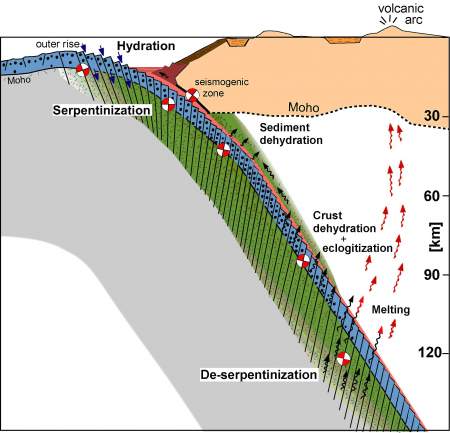 Web Content Display Web Content Display
Overview Theme A5
The subproject is aimed to study serpentinization (mantle hydration) in subduction zones Fig. A5-1). Recent research suggested that serpentinization is a key process occurring in subduction zones in two settings: (i) in the trench-outer rise seaward of the trench, when the plate is forced to subduct, and (ii) as fluids are released from the downgoing plate and infiltrate the mantle wedge. The first process is an important mechanism to carry chemically-bound water into the deep subduction zone, while the second process affects seismogenesis as serpentines are weak; thus, they limit the size of the seismogenic megathrust fault and hence earthquake hazards. Bound H2O stored within the oceanic lithosphere is associated with hydrothermal alteration. In general, hydrothermal activity decreases as the lithosphere moves away from a mid-ocean ridge, because the uppermost crust is sealed by precipitation of secondary alteration products and sediments deposited on top of the crust restrict the flow of seawater into the igneous basement. In the trench-outer rise area, where the subducting lithosphere bends into the trench, faulting associated with bending re-activates and creates new faults, cutting into the uppermost mantle. At sediment starved subduction zones (like Central America), bending-related faults breach the sedimentary cover to allow recharge and discharge of seawater; seawater reaches down to mantle depth and causes serpentinization. Offshore central Chile, however, up to 2 km of trench fill insulates the incoming plate from the ocean right before subduction. We will use (used) active and passive source seismic tomography to study seismic structure of crust and upper mantle to image systematic changes of seismic properties (as a function of depth) from the outer rise into the subduction zone. Changes in seismic velocity will be used to estimate the amount of water trapped within crust and mantle of the subducting plate. Tomography, receiver functions and shear wave splitting will be used to study the state of hydration of the mantle wedge. During the second phase A5 focused its activities on the Central American margin, while we aim to survey the Chilean margin in the third phase.
Fig. A5-1: Schematic description of hydration and de-hydration processes occurring from the trench-outer rise down to ~120 km where the generation of arc magmas occur. |
 Events Events
Kieler Wissenschaftler fühlen den 'Puls der Erde' Wie funktioniert die Recyclingmaschine der Erde?Nach elf Jahren endet der Kieler Sonderforschungsbereich 574 zu Subduktionszonen Final colloquium of SFB 574 Teilprojekt ÖffentlichkeitsarbeitMEERESFORSCHUNG FÜR MICH UND DICH |
|
©SFB574 // Wischhofstrasse 1-3 // D-24148 Kiel // T. +49 (0)431 600 1413 // elange [AT] geomar.de






